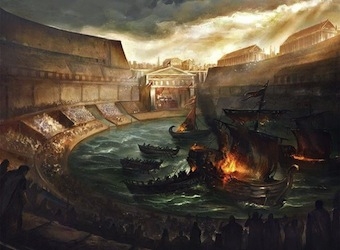
When you think of the Colosseum, gladiatorial combats are what come to mind. But did you know the Romans also held mock naval battles there by flooding the amphitheatre with water in the initial years after its inauguration in 80 A.D.? These were held to delight spectators as well as to demonstrate Rome’s might.
The Colosseum is the world’s largest amphitheater and one of the most recognizable symbols of Rome.
Construction of this grandiose building, also known as the Flavian Amphitheater, began in 70 AD by order of emperor Vespasian. Ten years later, it was completed under the rule of his son, Titus. The building’s opening ceremony in 80 AD was as impressive as the Colosseum itself, lasting for 100 days with games such as animal fighting and gladiator duels.
With dimensions of 513 by 620 feet, the Colosseum held between 50,000 and 80,000 spectators, averaging 65,000 attendants per event — a remarkable number even by today’s standards. Made of concrete and stone, this arena was in use for over 390 years and saw the deaths of more than 400,000 people and nearly a million animals.
The Colosseum was built by more than 60,000 Jewish slaves, who finished it in just ten years. The arena was later renovated several times, with underground tunnels (the hypogeum) added by emperor Domitian to hold animals and slaves, and a red canvas covering installed to shield spectators from rain.
The Colosseum was a venue for more than just gladiatorial games, though, used also for public executions and mythological plays. The Romans would often re-enact famous military victories, with free admission and food for all visitors. Perhaps the most spectacular events at the Colosseum, though, were the mock naval battles in the flooded arena.
These staged sea battles, called naumachiae, were held in places which could easily be flooded. The first recorded naumachia relates to the name of Julius Ceasar, just two years before he was assassinated. Namely, he wanted to celebrate some of his military efforts to Gaul and Egypt in 46 BC, hence he gave orders that a basin needs to be excavated in the proximity of river Tiber. The basin was used for an event in which some 2,000 prisoners fought against each other to the death. Four thousand rowers were present at the mock battle as well.
Some four decades later, in 2 BC, it was now the turn of Emperor Augustus. He had ordered the creation of similar basin, also by the river Tiber, and another event was staged. Some 3,000 peoples and 30 ships participated.
Some four decades later, in 2 BC, it was now the turn of Emperor Augustus. He had ordered the creation of similar basin, also by the river Tiber, and another event was staged. Some 3,000 peoples and 30 ships participated.
The first naumachia at the Colosseum had 3000 combatants and replicated an ancient battle between Athens and Syracuse. An artificial island was even built in the middle of the arena, where the sailors would disembark and continue to fight. Another naval battle in the Colosseum was staged in 89 AD by Domitian, which was the last recorded naumachia in Rome.
The popularity of staged naval battles decreased significantly over time, and the Colosseum was used mainly for more traditional combat sports. After nearly four centuries of use, the grand arena eventually fell into disrepair, and in the early medieval period, the Romans stopped using it for entertainment purposes. Over the next few centuries, it was used as a quarry, a fortress, a Christian shrine, and a source for building materials.
Credit : The Vintage News
Picture Credit : Google




